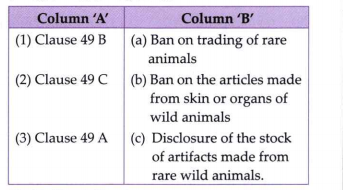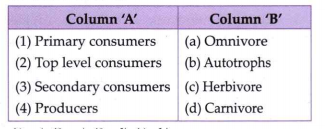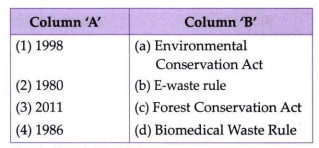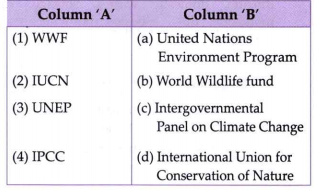Complete Solutions to EXERCISE of chapter Environmental Management of Class 10 book with complete answers and questions
| Class 10 | BIOLOGY |
| Chapter | Environmental Management |
| CHETANA PUBLICATION | EXERCISE |
| Number Of Questions | 100 |
| Academic Year | 2023-24 |
How many biodiversity spots are reported all over the World?
03:42View SolutionWhich of the following belongs to rare species?
01:24View SolutionWorld Biodiversity day is celebrated on_________.
01:13View SolutionThe Forest Conservation Act was enacted in __________.
01:22View Solution________ has been established in 2010 for effective implementation of environment related laws.
01:41View SolutionThe Chipko cenre is a voluntary environmental organization located in ________.
02:26View SolutionThe 'Red list' which contains the names of endangered species is prepared by __________.
02:50View SolutionPresently, only ______% of the Earth's area has been left with sensitive biodiversity.
01:58View Solution________ is the largest ecosystem.
01:46View SolutionThe MOlai Jungle is located in Kokilamukh of Jorhat district of _________.
01:25View SolutionThe science that deals with the study of interactions between biotic and abiotic factors of the environment is called_______.
02:16View SolutionIn human beings, sudden genetic changes are brought about by ________ pollution.
03:15View SolutionThe forest conserved in the name of God is called_______.
01:29View SolutionThe World's largest organization enagaged in environmental activities is ________.
01:52View SolutionWorld Biodiversity day is celebrated on_________.
01:13View Solution________ of Assam is under threat due to dams and indiscriminate use of water.
01:31View Solution_______ sanctuary of West Bengal is reserved for tigers.
01:43View SolutionWhich is the example of that plant which has seeds but not fruit ?
02:52View SolutionThe 'Red list' which contains the names of endangered species is prepared by __________.
02:50View SolutionFind the odd one out:
Air, water, animals, minerals.01:39View SolutionFind the odd one out:
Proteins, carbohydrates, fats, water.02:11View SolutionFind the odd one out:
Deer, tiger, frog, lion.02:33View SolutionFind the odd one out:
Water cycle , nitrogen cycle, oxygen cycle, carbon cycle.02:37View SolutionFind the odd one out:
Adverse effects of vision, genetic change, cancerous ulceration, tuberculosis.03:08View SolutionFind the odd one out:
`CO_2`, SO_3, O_3`, ketone.02:54View SolutionFind the odd one out:
Deer, elephant, zebra, wolf.01:30View SolutionFind the odd one out:
`CO_2`, dust, ash, asbestos.01:28View SolutionFind the odd one out:
IPCC, IUCN, BNHS, UNEP.03:41View SolutionFind the odd one out:
Asiatic cheetah, himalayan wolf, giant squirrel, pink headed duck.02:10View SolutionComplete the analogy:
Manas Sanctuary : Rhino : : Sunderban Sanctuary : _________01:00View SolutionComplete the analogy:
Red panda : Rare species : : Lion tailed monkey : ________.02:00View SolutionComplete the analogy:
Rare species : Musk deer : : Inderterminate species : ________02:26View SolutionComplete the analogy:
Endangered species : Liontailed monkey : : Vulnerable species : _________02:36View SolutionComplete the analogy:
Clause 49 B : Use of articles with animals parts banned : : Clause 49 C : __________02:15View SolutionComplete the analogy:
Sound pollution Rule : 2000 : : E-waste Rule : ________01:58View SolutionComplete the analogy:
1980 : Forest Conservation Act : : 1986 : ________01:11View SolutionComplete the analogy:
IUCN : International Union for Conservation of Nature : IPCC : _____01:46View SolutionComplete the analogy:
IPCC : Geneva : : IUCN : ________01:29View SolutionComplete the analogy:
Names of endangered species : Pink pages : : Names of presently safe species : _____01:34View SolutionMatch the following:
 02:18View Solution
02:18View SolutionMatch the following:
 02:21View Solution
02:21View SolutionMatch the following:
 01:48View Solution
01:48View SolutionMatch the following:
 01:57View Solution
01:57View SolutionMatch the following:
 04:13View Solution
04:13View SolutionMatch the following:
 02:18View Solution
02:18View SolutionMatch the following:
 02:32View Solution
02:32View SolutionMatch the following:
 02:13View Solution
02:13View SolutionState whether the following statements are true or false. Correc the false statement:
Wild animals like lion, tiger etc are not important for ecosystem.03:28View SolutionState whether the following statements are true or false. Correc the false statement:
The place where frogs are more, obviously snakes are less in that area.01:58View SolutionState whether the following statements are true or false. Correc the false statement:
The paddy fields are frequently attacked by grasshoppers.02:31View SolutionState whether the following statements are true or false. Correc the false statement:
Human existence is totally impossible without existence of nature.02:32View SolutionState whether the following statements are true or false. Correc the false statement:
Radioactive pollution can cause tuberculosis.02:40View SolutionState whether the following statements are true or false. Correc the false statement:
Wildlife Protection Act has been established in 1972.01:59View SolutionState whether the following statements are true or false. Correc the false statement:
Basic functional unit used to study the ecology is called ecosytem.02:20View SolutionState whether the following statements are true or false. Correct the false statement:
Earthquakes are man-made factors affecting environment.02:49View SolutionState whether the following statements are true or false. Correc the false statement:
UV and IR radiation are natural radiations.02:08View SolutionState whether the following statements are true or false. Correc the false statement:
Cancerous ulcerations occur due to higher radiations of X-rays.02:17View SolutionState whether the following statements are true or false. Correc the false statement:
Environment is made up of one type of ecosystem.02:54View SolutionState whether the following statements are true or false. Correc the false statement:
The Earth is sufficient to satisfy everyone's need but not the greed.03:16View SolutionState whether the following statements are true or false. Correc the false statement:
Sound pollution Control and Prevention Rule was estalished in 2011.01:47View SolutionState whether the following statements are true or false. Correc the false statement:
A species can be possibly wiped out if there is a decrease in the diversity within the species that reproduce sexually.04:08View SolutionState whether the following statements are true or false. Correc the false statement:
Bacteria are generally good decomposers.02:04View SolutionState whether the following statements are true or false. Correc the false statement:
All over the world 76 spots are reported as highly sensitive biodiversity spots.02:16View SolutionComplete the following food chain by arranging in a proper sequence.
Cow, Tiger, Grass02:13View SolutionComplete the following food chain by arranging in a proper sequence.
Frog, Insect, Grass, Hawk, Snake03:31View SolutionComplete the following food chain by arranging in a proper sequence.
Tiger, Rabbit, Wolf, Grass03:05View SolutionComplete the following food chain by arranging in a proper sequence.
Algae, Snake, Insect, Frog, Mongoose03:18View SolutionComplete the following food chain by arranging in a proper sequence.
Insect, Tree, Fowl, Man02:41View SolutionComplete the following food chain by arranging in a proper sequence.
Goat, Man, Grass03:17View SolutionComplete the following food chain by arranging in a proper sequence.
Grasshopper, snake, Frog, Grass, Eagle02:52View SolutionComplete the following food chain by arranging in a proper sequence.
Lion, Deer, Grass02:12View SolutionComplete the following food chain by arranging in a proper sequence.
Grasshopper, snake, Frog, Grass, Eagle02:52View SolutionName the following:
Secondary Consumers03:49View SolutionName the following:
Primary Consumers04:03View SolutionName the following:
Omnivores03:03View SolutionName the following:
Carnivores03:24View SolutionName the following:
Saprophyte02:07View SolutionName the following:
Abiotic factors02:25View SolutionName the following:
Autotrophs03:13View SolutionName the following:
Heterotrophs03:27View SolutionName the following:
Biotic factors02:55View SolutionName the following:
Air pollutants05:16View SolutionName the following:
Endangered species03:05View SolutionName the following:
Largest ecosystem01:42View SolutionName the following:
Rare Species02:57View SolutionName the following:
Decomposers02:32View SolutionName the following:
International environmental organization.02:30View SolutionForest conserved in the name of God
02:29View SolutionVoluntary Organizations engaged in environmental activities is India.
03:42View SolutionWorld's largest organization engaged in environmental activities.
01:25View SolutionDiseases caused by radiations.
04:02View SolutionName the following:
Water pollutants05:35View SolutionName the following:
Clause for ban on trading rare animals03:27View SolutionMake list of the following.
Animals and plants from jungle ecosytem.05:46View SolutionMake list of the following.
Animals and plants from grassland ecosystem.03:36View SolutionMake list of the following.
Animals and plants from pond ecosystem.04:31View SolutionClassify the following into biotic and abiotic factors:
02:21View SolutionClassify the following into Primary Consumers and Secondary Consumers:
04:32View SolutionClassify the following into Air Pollutants and Water Pollutants.
05:12View SolutionClassify the following into Voluntary Organizations and International Environmental Organization:
04:29View Solution
EXERCISE questions and complete solutions for chapter Environmental Management of CHETANA BIOLOGY (MARATHI ENGLISH) of Class 10
